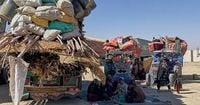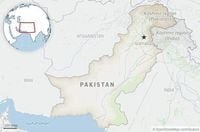It was a night of gunfire, explosions, and angry rhetoric along one of the world’s most volatile borders. On October 12, 2025, Afghanistan’s Taliban-led government announced what it called a major retaliatory campaign against Pakistan, claiming the deaths of 58 Pakistani soldiers and the capture of 25 military posts. The operation, Afghan officials said, was a direct response to what they described as repeated violations of their territory and airspace—accusations that Pakistan has forcefully denied.
According to the Associated Press, the Taliban government’s chief spokesman, Zabihullah Mujahid, told a news conference in Kabul that "the situation on all official borders and de facto lines of Afghanistan is under complete control, and illegal activities have been largely prevented." He added that 30 Pakistani soldiers had been wounded in the overnight fighting, which raged across multiple border points. The Taliban Defense Ministry echoed this, describing the operations as both "retaliatory and successful," and warning, "If the opposing side again violates Afghanistan's territorial integrity, our armed forces are fully prepared to defend the nation's borders and will deliver a strong response."
Pakistan’s version of events, however, painted a very different picture. Islamabad’s army reported far fewer casualties—23 dead, according to their own tally—and said its forces had "not only gave a befitting reply to Afghanistan’s provocations but also destroyed several of their posts, forcing them to retreat," as Prime Minister Shehbaz Sharif stated. Security officials in Pakistan claimed to have captured 19 Afghan border posts from which they said attacks were being launched. Videos circulated by Pakistani security sources purported to show destroyed Afghan checkpoints and, in one case, Afghan soldiers surrendering to Pakistani forces in Kurram. However, these claims could not be independently verified due to strict media access restrictions in the conflict zone.
The fighting was particularly intense at several key points along the border. Afghan forces targeted Pakistani posts at Angoor Adda, Bajaur, Kurram, Dir, and Chitral in Khyber Pakhtunkhwa province, as well as Baramcha in Balochistan, according to reporting from The Economic Times. Pakistani forces retaliated with artillery, tanks, drones, and air support, destroying what they described as a Taliban tank position and striking the Second Battalion Headquarters of the First Brigade of Afghan security forces in Baramcha. Pakistani sources claimed this headquarters was used to deploy militants from the banned Tehreek-e-Taliban Pakistan (TTP), a group Islamabad blames for a recent wave of deadly attacks inside Pakistan.
The roots of this latest escalation stretch back to earlier in the week. Kabul and an eastern Afghan market were reportedly bombed in attacks Afghan authorities blamed on Pakistan, though Islamabad did not claim responsibility. The situation quickly deteriorated after a terrorist attack in Khyber Pakhtunkhwa’s Orakzai district left 11 Pakistani military personnel dead, including a lieutenant colonel and a major. Pakistan has long accused the Afghan government of harboring the TTP, which Kabul denies. “Firing by Afghan forces on the civilian population is a blatant violation of international laws. Pakistan’s brave forces have given a prompt and effective response that no provocation will be tolerated,” Pakistan’s Interior Minister Mohsin Naqvi declared, adding that the country’s forces were prepared to answer Afghanistan "with stones for bricks."
The impact on civilians and commerce was immediate. Both the Torkham and Chaman border crossings—vital trade arteries between the two countries—remained closed on Sunday, turning away refugees and traders alike. An Associated Press reporter in Chaman heard jets overhead and saw smoke rising from Spin Boldak, a city in Afghanistan’s southern Kandahar province, after an explosion. The closures stranded Afghans trying to leave Pakistan and left truckloads of goods idle at border gates, highlighting how quickly regional tensions can disrupt everyday life.
Regional powers did not sit idly by. Saudi Arabia’s Foreign Ministry urged "restraint, avoidance of escalation and the adoption of dialogue and wisdom to help de-escalate tensions and maintain the security and stability of the region." Qatar echoed these calls. Afghan Foreign Minister Amir Khan Muttaqi, who happened to be in India at the time, acknowledged the Gulf states’ appeals for calm but insisted his country reserved the right to defend itself: "We want a peaceful resolution of the situation, but if the peace efforts don’t succeed, we have other options," he told journalists. India, meanwhile, has recently upgraded its diplomatic presence in Kabul, a move that has not gone unnoticed in Islamabad, which also accuses India of backing armed groups operating against Pakistan—though no evidence has been provided.
As the two nuclear-armed neighbors traded accusations and artillery fire, their mutual border—the 2,611-kilometer Durand Line—remained a flashpoint. Afghanistan has never recognized the Durand Line as an official boundary, and the demarcation has been a source of tension since the days of British colonial rule. The latest round of fighting saw both sides accuse the other of unprovoked aggression and targeting civilians, with each claiming to have inflicted heavy losses and seized enemy positions.
Pakistani sources told Radio Pakistan that their forces had targeted "terrorist camps and hideouts of khawarij, ISIS located near the Pak-Afghan border inside Afghanistan with great precision," and that Afghan forces had retreated from several areas. They also claimed to have destroyed Durani Camp No. 2—described as a launch pad for cross-border terrorist activity—with initial reports suggesting over 50 Taliban and foreign fighters were killed. Meanwhile, Afghan officials maintained that their operations were purely defensive, aimed at stopping what they called persistent violations of their sovereignty.
The fog of war made it difficult to verify either side’s claims. Pakistani officials said Afghan forces had opened fire in several northwestern border areas, while Afghan authorities accused Pakistan of bombing Kabul and eastern provinces. Both sides reported using heavy weaponry, and both insisted they had the upper hand. What is clear is that the violence marked a sharp escalation in tensions between two countries already grappling with internal instability, resurgent militancy, and economic hardship.
As the dust settles, the border remains tense, with thousands of soldiers on high alert and border crossings closed. The international community is watching closely, wary of the potential for wider regional instability. For now, both Kabul and Islamabad insist they are ready for peace—but neither appears willing to back down.
With the border bristling and diplomatic efforts just beginning, the next chapter in this fraught relationship remains uncertain, leaving millions on both sides hoping for calm amid the echoes of gunfire.


